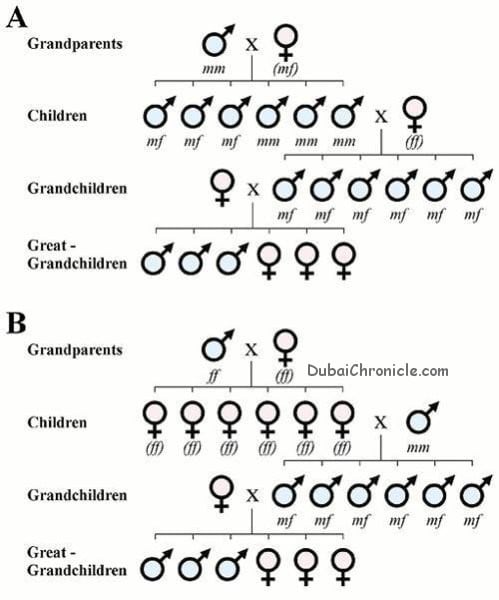
A Newcastle University study involving thousands of families is helping prospective parents work out whether they are likely to have sons or daughters.
The work by Corry Gellatly, a research scientist at the university, has shown that men inherit a tendency to have more sons or more daughters from their parents. This means that a man with many brothers is more likely to have sons, while a man with many sisters is more likely to have daughters.
The research involved a study of 927 family trees containing information on 556,387 people from North America and Europe going back to 1600.
“The family tree study showed that whether you’re likely to have a boy or a girl is inherited. We now know that men are more likely to have sons if they have more brothers but are more likely to have daughters if they have more sisters. However, in women, you just can’t predict it,” Mr Gellatly explains.
Men determine the sex of a baby depending on whether their sperm is carrying an X or Y chromosome. An X chromosome combines with the mother’s X chromosome to make a baby girl (XX) and a Y chromosome will combine with the mother’s to make a boy (XY).
The Newcastle University study suggests that an as-yet undiscovered gene controls whether a man’s sperm contains more X or more Y chromosomes, which affects the sex of his children. On a larger scale, the number of men with more X sperm compared to the number of men with more Y sperm affects the sex ratio of children born each year.
Sons or daughters?
A gene consists of two parts, known as alleles, one inherited from each parent. In his paper, Mr Gellatly demonstrates that it is likely men carry two different types of allele, which results in three possible combinations in a gene that controls the ratio of X and Y sperm;
Men with the first combination, known as mm, produce more Y sperm and have more sons.
The second, known as mf, produce a roughly equal number of X and Y sperm and have an approximately equal number of sons and daughters.
The third, known as ff produce more X sperm and have more daughters.
“The gene that is passed on from both parents, which causes some men to have more sons and some to have more daughters, may explain why we see the number of men and women roughly balanced in a population. If there are too many males in the population, for example, females will more easily find a mate, so men who have more daughters will pass on more of their genes, causing more females to be born in later generations,” says Newcastle University researcher Mr Gellatly.
More boys born after the wars
In many of the countries that fought in the World Wars, there was a sudden increase in the number of boys born afterwards. The year after World War I ended, an extra two boys were born for every 100 girls in the UK, compared to the year before the war started. The gene, which Mr Gellatly has described in his research, could explain why this happened.
As the odds were in favour of men with more sons seeing a son return from the war, those sons were more likely to father boys themselves because they inherited that tendency from their fathers. In contrast, men with more daughters may have lost their only sons in the war and those sons would have been more likely to father girls. This would explain why the men that survived the war were more likely to have male children, which resulted in the boy-baby boom.
In most countries, for as long as records have been kept, more boys than girls have been born. In the UK and US, for example, there are currently about 105 males born for every 100 females.
It is well-documented that more males die in childhood and before they are old enough to have children. So in the same way that the gene may cause more boys to be born after wars, it may also cause more boys to be born each year.
How does the gene work?
The trees illustrate how the gene works. It is a simplified example, in which men either have only sons, only daughters, or equal numbers of each, though in reality it is less clear cut. It shows that although the gene has no effect in females, they also carry the gene and pass it to their children.

In the first family tree (A) the grandfather is mm, so all his children are male. He only passes on the m allele, so his children are more likely to have the mm combination of alleles themselves. As a result, those sons may also have only sons (as shown). The grandsons have the mf combination of alleles, because they inherited an m from their father and an f from their mother. As a result, they have an equal number of sons and daughters (the great grandchildren).
In the second tree (B) the grandfather is ff, so all his children are female, they have the ff combination of alleles because their father and mother were both ff. One of the female children has her own children with a male who has the mm combination of alleles. That male determines the sex of the children, so the grandchildren are all male. The grandsons have the mf combination of alleles, because they inherited an m from their father and f from their mother. As a result, they have an equal number of sons and daughters (the great-grandchildren).




































